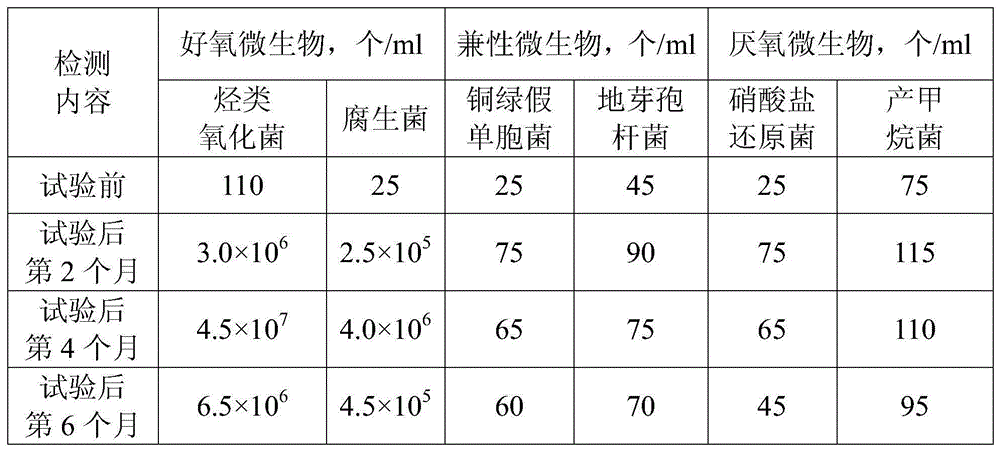Method for improving oil recovery efficiency through microbial oil displacement
A technology of microbial oil flooding and oil recovery, applied in the fields of fluid production, earthwork drilling, wellbore/well components, etc., can solve the problem that the deep facultative and anaerobic bacteria cannot be fully activated in the oil reservoir, and the biological inhibitory dose is difficult. Control and affect the effect of field tests, etc., to achieve the effect of low price, wide application range, pertinence and strong operability
- Summary
- Abstract
- Description
- Claims
- Application Information
AI Technical Summary
Problems solved by technology
Method used
Image
Examples
Embodiment 1
[0028] A block A in Shengli Oilfield is a high salinity, medium-high viscosity unconsolidated sandstone reservoir, with a burial depth of 1173m-1230m, a reservoir temperature of 55°C, a reservoir pressure of 15MPa, a porosity of 30.0%, and a pore volume of 2.4×10 4 m 3 , recoverable reserves 5.6×10 4 t, the formation water salinity is 14767mg / L. Implementing the concrete implementation steps of the present invention in this block is:
[0029] (1) On-site sampling and detection of endogenous microorganisms in the test block
[0030] The endogenous microorganisms detected include aerobic, facultative and anaerobic microorganisms, among which aerobic microorganisms are hydrocarbon oxidizing bacteria and saprophytic bacteria, facultative microorganisms are Pseudomonas aeruginosa and Geobacillus, anaerobic microorganisms are nitrate The test results of reducing bacteria and methanogenic bacteria in Block A are shown in Table 1.
[0031] Table 1 Specific test results of field sa...
Embodiment 2
[0054] A block B in Shengli Oilfield is a high salinity, medium-high viscosity unconsolidated sandstone reservoir, with a burial depth of 1245m-1320m, a reservoir temperature of 65°C, a reservoir pressure of 12MPa, a porosity of 31.5%, and a pore volume of 5.2×10 4 m 3 , recoverable reserves 4.6×10 4 t, the formation water salinity is 12750mg / L. Implementing the concrete implementation steps of the present invention in this block is:
[0055] (1) On-site sampling and detection of endogenous microorganisms in the test block
[0056] The endogenous microorganisms detected include aerobic, facultative and anaerobic microorganisms, among which aerobic microorganisms are hydrocarbon oxidizing bacteria and saprophytic bacteria, facultative microorganisms are Pseudomonas aeruginosa and Geobacillus, anaerobic microorganisms are nitrate The test results of reducing bacteria and methanogenic bacteria in Block B are shown in Table 5.
[0057] Table 5 Specific test results of field sa...
Embodiment 3
[0080] A block C in Shengli Oilfield is a high salinity, medium-high viscosity unconsolidated sandstone reservoir, with a burial depth of 1302m-1358m, a reservoir temperature of 75°C, a reservoir pressure of 13MPa, a porosity of 32.3%, and a pore volume of 1.8×10 5 m 3 , recoverable reserves 8.9×10 4 t, the formation water salinity is 9870mg / L. Implementing the concrete implementation steps of the present invention in this block is:
[0081] (1) On-site sampling and detection of endogenous microorganisms in the test block
[0082] The endogenous microorganisms detected include aerobic, facultative and anaerobic microorganisms, among which aerobic microorganisms are hydrocarbon oxidizing bacteria and saprophytic bacteria, facultative microorganisms are Pseudomonas aeruginosa and Geobacillus, anaerobic microorganisms are nitrate The test results of reducing bacteria and methanogenic bacteria in Block C are shown in Table 9.
[0083] Table 9 Specific test results of field sam...
PUM
| Property | Measurement | Unit |
|---|---|---|
| Particle size | aaaaa | aaaaa |
Abstract
Description
Claims
Application Information
 Login to View More
Login to View More - R&D
- Intellectual Property
- Life Sciences
- Materials
- Tech Scout
- Unparalleled Data Quality
- Higher Quality Content
- 60% Fewer Hallucinations
Browse by: Latest US Patents, China's latest patents, Technical Efficacy Thesaurus, Application Domain, Technology Topic, Popular Technical Reports.
© 2025 PatSnap. All rights reserved.Legal|Privacy policy|Modern Slavery Act Transparency Statement|Sitemap|About US| Contact US: help@patsnap.com



